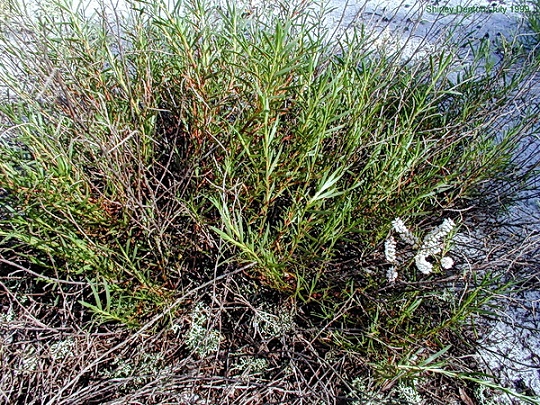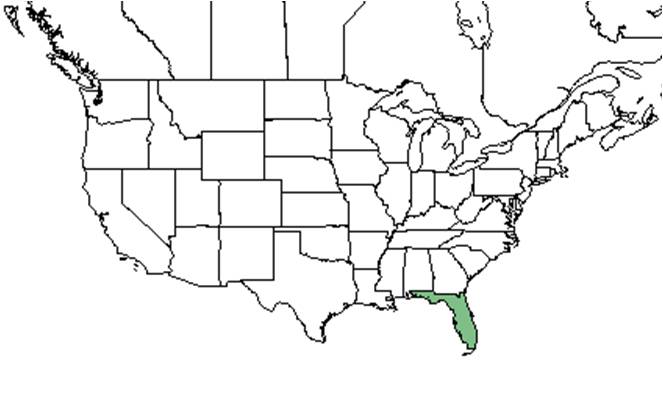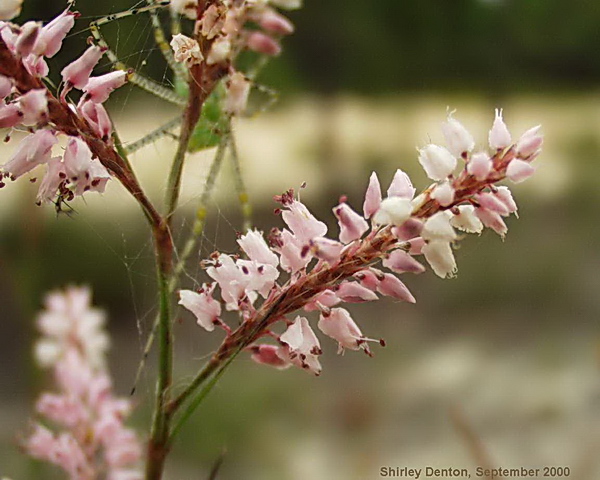Difference between revisions of "Polygonum nesomii"
(→Pollination) |
|||
| Line 66: | Line 66: | ||
<!--===Diseases and parasites===--> | <!--===Diseases and parasites===--> | ||
| − | ==Conservation and | + | ==Conservation, cultivation, and restoration== |
| − | == | + | |
| + | ==Cultural use== | ||
==Photo Gallery== | ==Photo Gallery== | ||
<gallery widths=180px> | <gallery widths=180px> | ||
Revision as of 18:54, 8 June 2021
| Polygonum nesomii | |
|---|---|

| |
| Synonym Polygonella robusta shown, Photo by Shirley Denton (Copyrighted, use by photographer’s permission only), Nature Photography by Shirley Denton | |
| Scientific classification | |
| Kingdom: | Plantae |
| Division: | Magnoliophyta - Flowering plants |
| Class: | Magnoliopsida – Dicotyledons |
| Order: | Caryophyllales |
| Family: | Polygonaceae |
| Genus: | Polygonella |
| Species: | P. nesomii |
| Binomial name | |
| Polygonum nesomii (Small) G.L. Nesom & V.M. Bates | |

| |
| Natural range of Polygonum nesomii from USDA NRCS Plants Database. | |
Common name: Largeflower jointweed
Contents
Taxonomic notes
Synonyms: Polygonella robusta (Small) G.L. Nesom & Bates; Polygonella fimbriata (Elliott) Horton var. robusta (Small) Horton; Thysanella robusta Small
Description
A description of Polygonum nesomii is provided in The Flora of North America.
Distribution
P. nesomii can be found in sandy habitat throughout Florida.[1]
Ecology
Habitat
In the Coastal Plain in Florida, P. robusta can occur in sandy old fields, Florida rosemary scrubs, sand dunes, and xeric oak/saw palmetto scrubs.[2] Associated species include saw palmetto and scrub oaks.
Phenology
The flowers range from light pink to deep pink with the colors changing as the flowers mature and age, eventually turning rusty orange.[3] Blooms throughout summer and fall.[4]
Seed bank and germination
Lindon and Menges (2008) found that germination rates under smoke was less than without smoke.
Germination rates are negatively affected by the allelopathic chemicals leached from the Florida rosemary.[5]
Fire ecology
P. nesomii is an obligate seeder. Weekley and Menges (2003) found that two years post fire, there were individuals established in new areas.
Pollination
The following Hymenoptera families and species were observed visiting flowers of Polygonella robusta at Archbold Biological Station:[6]
Apidae: Apis mellifera, Bombus impatiens
Colletidae: Colletes mandibularis, Hylaeus confluens
Halictidae: Augochlorella aurata, Augochloropsis anonyma, A. sumptuosa, Lasioglossum miniatulus, L. nymphalis, L. placidensis, Sphecodes heraclei
Leucospididae: Leucospis robertsoni, L. slossonae
Megachilidae: Anthidiellum perplexum, Coelioxys octodentata, C. sayi, Megachile albitarsis
Pompilidae: Anoplius marginalis, Episyron conterminus posterus, Paracyphonyx funereus
Sphecidae: Bembix sayi, Bicyrtes capnoptera, Cerceris flavofasciata floridensis, Ectemnius rufipes ais, Isodontia exornata, Larra bicolor, Oxybelus emarginatus, O. laetus fulvipes, Philanthus politus, P. ventilabris, Tachysphex similis, Tachytes grisselli, T. validus
Vespidae: Eumenes fraternus, E. smithii, Euodynerus boscii boharti, Monobia quadridens, Pachodynerus erynnis, Parancistrocerus salcularis rufulus, Polistes bellicosus, P. dorsalis hunteri, Pseudodynerus quadrisectus, Stenodynerus beameri, S. fundatiformis, S. histrionalis rufustus, S. lineatifrons, S. oculeus, S. pulvinatus surrufus, Zethus slossonae
Conservation, cultivation, and restoration
Cultural use
Photo Gallery
Flowers of Polygonella robusta Photo by Shirley Denton (Copyrighted, use by photographer’s permission only), Nature Photography by Shirley Denton
References and notes
Lindon, H. L. and E. Menges (2008). "Scientific Note: Effects of Smoke on Seed Germination of Twenty Species of Fire-Prone Habitats in Florida." Castanea 73(2): 106-110.
Weekley, C. W. and E. S. Menges (2003). "Species and Vegetation Responses to Prescribed Fire in a Long-Unburned, Endemic-Rich Lake Wales Ridge Scrub." The Journal of the Torrey Botanical Society 130(4): 265-282.
- ↑ Satya, M.-W., E. S. Menges, et al. (2005). "Microhabitat Distribution of Two Florida Scrub Endemic Plants in Comparison to Their Habitat-Generalist Congeners." American Journal of Botany 92(3): 411-421.
- ↑ Florida State University Robert K. Godfrey Herbarium database. URL: http://herbarium.bio.fsu.edu. Last accessed: November 2015. Collectors: K. Godfrey, Robert L. Lazor, Julie Neel, Cecil R. Slaughter. States and Counties: Florida: Franklin, Madison, Osceola, Wakulla. Compiled by Tall Timbers Research Station and Land Conservancy.
- ↑ [[1]]
- ↑ [[2]]Floridata. Accessed: February 25, 2016
- ↑ Hewitt, R. E. and E. S. Menges (2008). "Allelopathic Effects of Ceratiola ericoides (Empetraceae) on Germination and Survival of Six Florida Scrub Species." Plant Ecology 198(1): 47-59
- ↑ Deyrup, M.A. and N.D. 2015. Database of observations of Hymenoptera visitations to flowers of plants on Archbold Biological Station, Florida, USA.
